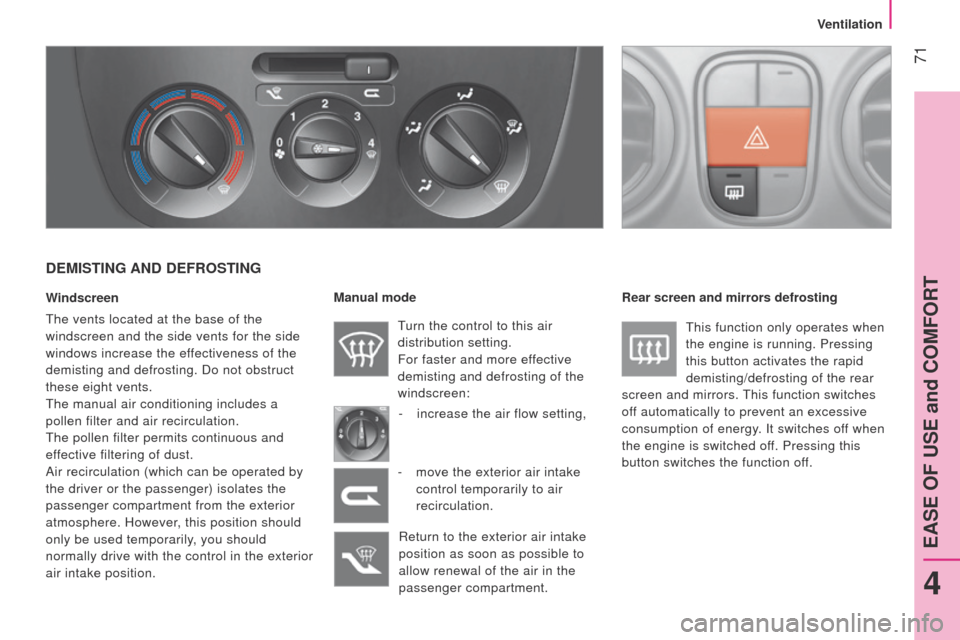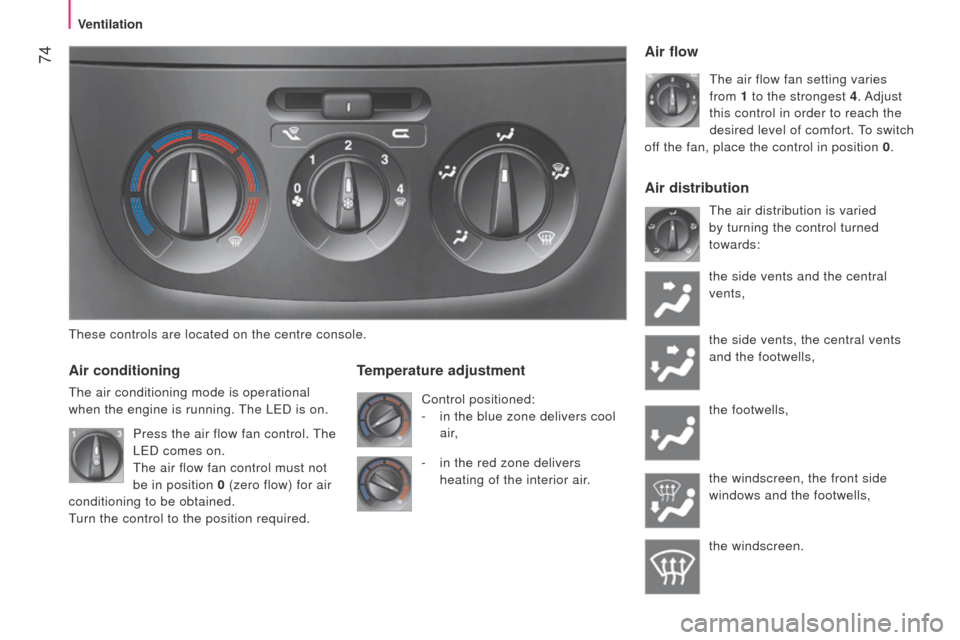Page 73 of 192

71
Bipper_en_Chap04_ergonomie_ed02-2014
DEMISTING AND DEFROSTING
Windscreen
t
he vents located at the base of the
windscreen and the side vents for the side
windows increase the effectiveness of the
demisting and defrosting. Do not obstruct
these eight vents.
t
he manual air conditioning includes a
pollen filter and air recirculation.
t
he pollen filter permits continuous and
effective filtering of dust.
Air recirculation (which can be operated by
the driver or the passenger) isolates the
passenger compartment from the exterior
atmosphere. However, this position should
only be used temporarily, you should
normally drive with the control in the exterior
air intake position. Manual mode
turn the control to this air
distribution setting.
For faster and more effective
demisting and defrosting of the
windscreen:
-
increase the air flow setting,
Return to the exterior air intake
position as soon as possible to
allow renewal of the air in the
passenger compartment. Rear screen and mirrors defrosting
t
his function only operates when
the engine is running. Pressing
this button activates the rapid
demisting/defrosting of the rear
screen and mirrors.
t
his function switches
off automatically to prevent an excessive
consumption of energy. It switches off when
the engine is switched off. Pressing this
button switches the function off.
-
move the exterior air intake
control temporarily to air
recirculation.
4
EASE OF USE and COMFORT
Ventilation
Page 76 of 192

74
Bipper_en_Chap04_ergonomie_ed02-2014
these controls are located on the centre console.
Air conditioning
the air conditioning mode is operational
when the engine is running.
t
he le D is on.
Temperature adjustment
Control positioned:
-
in the blue zone delivers cool
air,
Air flow
the air flow fan setting varies
from 1 to the strongest
4. Adjust
this control in order to reach the
desired level of comfort.
to switch
off the fan, place the control in position 0 .
t
he air distribution is varied
by turning the control turned
towards:
the side vents and the central
vents,
the side vents, the central vents
and the footwells,
the footwells,
the windscreen, the front side
windows and the footwells,
the windscreen.
Press the air flow fan control.
t
he
le
D comes on.
t
he air flow fan control must not
be in position 0 (zero flow) for air
conditioning to be obtained.
turn the control to the position required. -
in the red zone delivers
heating of the interior air.
Air distribution
Ventilation
Page 86 of 192
84
Bipper_en_Chap05_technologie_ed02-2014
Level 1 screen
- Speed (speed beep).
- t
ime (Setting the time).
-
Buzz (V
olume for announcements).
-
u nit ( u nits of measurement).
-
Bag p (Passenger's airbag).
Refer to the corresponding line of the
configuration - personalisation table on the
following pages.
CONFIGURATION /
P ERSONALISATION OF THE VEHICLE
Level 2 screen
Refer to the corresponding line of the
configuration - personalisation table on the
following pages.
Control panel
the side control panel located beside the
steering wheel provides access to screen
menus allowing personalisation of some of
your systems.
e
ight languages are available: Italian,
e
nglish, g erman, French, Spanish,
Portuguese, Dutch and
turkish.
As a safety precaution, the menus can
only be accessed when the ignition is
off (engine off).
Vehicle configuration
Page 89 of 192
87
Bipper_en_Chap05_technologie_ed02-2014
Menu...Press... Sub-menu... Press... Select... Confirm
and exitEnables you to...
11 Service (Km/Miles before
oil change)Display the miles/kilometres
remaining before the next oil
change.
Display the engine
oil level.
12 Bag p ON
Ye s
Activate the passenger's front
airbag.
No
OFF Ye s
Deactivate the passenger's
front airbag.
No
13
exit from menuQuit the menu.
Press the arrow at the bottom
to go to the first menu.
5
TECHNOLOGY on BOARD
Vehicle configuration
Page 115 of 192

11 3
Bipper_en_Chap06_securite_ed02-2014
Emergency braking assistance*
System which, in an emergency, enables
you to reach the optimum braking pressure
more quickly, thus reducing the stopping
distance.
t
he emergency braking assistance
is an integral part of the DSC system
Activation
It is brought into play by the speed at which
the brake pedal is pressed.
t
he effect of this is a reduction in the
resistance of the pedal and an increase in
braking efficiency.
When braking in an emergency, press firmly
without releasing the pressure.
Good practice
t
his system cannot be deactivated by the
driver.
* Depending on country of sale.
TRAJECTORY CONTROL SYSTEMS
Dynamic stability control
(DSC)
the dynamic stability control system acts on
the brake of one or more wheels and on the
engine to keep the vehicle on the trajectory
required by the driver, within the limits of the
laws of physics.
Activation
t
his system is activated automatically each
time the vehicle is started and cannot be
deactivated.
It comes into operation in the event of a grip
or trajectory problem.
Illumination of this warning lamp,
accompanied by a message in the
instrument panel screen, indicates
a fault with the system, which is
deactivated automatically.
Have it checked by a P
euge O t
dealer or a
qualified workshop.
Anti-slip regulation (ASR) and engine
control (MSR)
Anti-slip regulation (also known as traction
control) optimises traction, avoiding wheel
spin by acting on the brakes of the driving
wheels and the engine.
e
ngine control is an integral part of the ASR
system and intervenes when a sudden gear
change is made or of one of the driving
wheels looses grip, by reducing engine
torque to avoid loss of stability of the vehicle.
Activation
t
hese systems are activated automatically
every time the vehicle is started.
In the event of a problem od adhesion or
trajectory, these systems come into play.
Deactivation
In exceptional conditions (starting a vehicle
which is bogged down, stuck in snow,
on soft ground...), it may be advisable to
deactivate the ASR system, so that the
wheels can spin freely and regain grip.
t
his is indicated by flashing of this
warning lamp in the instrument
panel.
Operating fault
6
SAFETY
Driving safely
Page 120 of 192

11 8
Bipper_en_Chap06_securite_ed02-2014
FRONT SEAT BELTS
the front seats are fitted with pre-tensioners
and force limiters.
Fastening
Pull the strap, then insert the tongue into the
buckle.
Check that the seat belt is fastened correctly
by pulling the strap.
t
he lap belt must be positioned as low as
possible on the pelvis.
t
he chest belt must
pass over the hollow of the shoulder.
Inertia reel seat belts
these are fitted with a device which locks
automatically in the event of a collision or
emergency braking.
Safety in the event of a front impact has
been improved by the introduction of
pretensioning and force limiting seat belts.
Depending on the seriousness of the
impact, the pretensioning system instantly
tightens the seat belt against the body of the
occupant.
t
he pretensioning seat belts are active when
the ignition is on.
t
he force limiter reduces the pressure of the
seat belt against the body of the occupant in
the event of an accident.
Driver's seat belt not fastened warning
lamp
When the vehicle is started, this
warning lamp comes on if the
driver has not fastened their seat
belt.
REAR SEAT BELTS (COMBI)
the 3-seat bench is fitted with three-point
inertia reel seat belts with force limiter .
t
he centre seat has a seat belt guide and
inertia reel, integrated with the seat back.
When a seat belt is not in use, you can
store its buckle in the housing provided
in the bench seat cushion.
If the driver's seat belt is unfastened,
the S
t
ARt mode of Stop & Start will
not be invoked.
t
he engine can only be
restarted using the ignition key.
Seat belts
Page 139 of 192
137
Bipper_en_Chap07_accessoire_ed02-2014
TOWING A TRAILER, CARAVAN, ETC...
Driving advice
As the fan is electrically controlled, its
cooling capacity is not dependent on the
engine speed.
On the contrary, use a high gear to lower the
engine speed and reduce your speed.In all cases, pay attention to the coolant
temperature.
A towed vehicle must free wheel: gearbox in
neutral.
Cooling: towing a trailer on a slope
increases the coolant temperature.
7
ACCESSORIES
Towing a trailer
Page 140 of 192

138
Bipper_en_Chap07_accessoire_ed02-2014
In certain cases of particularly arduous
use (towing the maximum load up a steep
slope in high temperatures), the engine
automatically limits its power. In this case,
automatic cutting off of the air conditioning
allows the engine power to be saved.If the coolant temperature
warning lamp comes on, stop the
vehicle and switch off the engine
as soon as possible.
ChecksSee the "
l evels" section of
chapter 7.
Tyres: check the tyre pressures on the
towing vehicle and the trailer, observing the
recommended pressures.
Brakes: towing increases the braking
distance. Drive at a moderate speed,
change down early and brake gradually. Side wind: sensitivity to side wind is
increased. Drive smoothly and at a
moderate speed.
ABS: the system only controls the vehicle,
not the trailer.
Distribution of loads
Distribute the load in the trailer so that the
heaviest objects are as close as possible
to the axle and the nose weight is close to
the maximum authorised without, however,
exceeding it.
t
he air density decreases with
altitude, so reducing the performance of the
engine.
t
he maximum towed load must be
reduced by 10 % for each 1 000 metres of
altitude.
Refer to the "
t
echnical data -
Identification markings" section. Rear parking sensors: the sensors will be
deactivated automatically when an genuine
P
euge O t towbar is used.
Towbar
We recommend the use of genuine
P
euge O t towbars and their harnesses,
which have been tested and approved from
the design stage of your vehicle, and that
the fitting of this equipment is entrusted to a
P
euge O t
dealer or a qualified workshop.
If this equipment is not fitted by a P
euge O t
dealer
, it is essential that it is fitted using
the electrical pre-equipment located at
the rear of the vehicle and following the
manufacturer's instructions.
t
he operation of the rear parking sensors is
deactivated automatically when the trailer
cable connector is inserted in the towbar
socket.
When the trailer cable is removed, the rear
parking sensors are re-activated.
Refer to the "
t
echnology on board -
Parking sensors" section.
For information on the maximum
weights and towed loads applicable to
your vehicle, refer to the "
t
echnical data -
Weights" section.
Towing a trailer